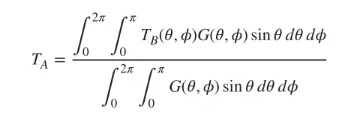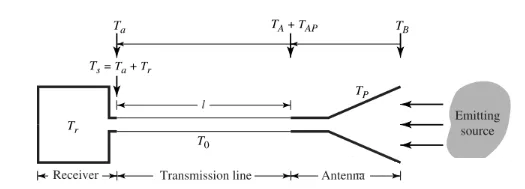Objects with actual temperatures above absolute zero will radiate energy. The amount of radiated energy is usually expressed in equivalent temperature TB, usually called brightness temperature, which is defined as:

TB is the brightness temperature (equivalent temperature), ε is the emissivity, Tm is the actual molecular temperature, and Γ is the surface emissivity coefficient related to the polarization of the wave.
Since the emissivity is in the interval [0,1], the maximum value that the brightness temperature can reach is equal to the molecular temperature. In general, the emissivity is a function of the operating frequency, the polarization of the emitted energy, and the structure of the object's molecules. At microwave frequencies, the natural emitters of good energy are the ground with an equivalent temperature of about 300K, or the sky in the zenith direction with an equivalent temperature of about 5K, or the sky in the horizontal direction of 100~150K.
The brightness temperature emitted by different light sources is intercepted by the antenna and appears at the antenna end in the form of antenna temperature. The temperature appearing at the antenna end is given based on the above formula after weighting the antenna gain pattern. It can be expressed as:

TA is the antenna temperature. If there is no mismatch loss and the transmission line between the antenna and the receiver has no loss, the noise power transmitted to the receiver is:

Pr is the antenna noise power, K is the Boltzmann constant, and △f is the bandwidth.

figure 1
If the transmission line between the antenna and the receiver is lossy, the antenna noise power obtained from the above formula needs to be corrected. If the actual temperature of the transmission line is the same as T0 over the entire length, and the attenuation coefficient of the transmission line connecting the antenna and the receiver is a constant α, as shown in Figure 1. At this time, the effective antenna temperature at the receiver endpoint is:

Where:

Ta is the antenna temperature at the receiver endpoint, TA is the antenna noise temperature at the antenna endpoint, TAP is the antenna endpoint temperature at physical temperature, Tp is the antenna physical temperature, eA is the antenna thermal efficiency, and T0 is the physical temperature of the transmission line.
Therefore, the antenna noise power needs to be corrected to:

If the receiver itself has a certain noise temperature T, the system noise power at the receiver endpoint is:

Ps is the system noise power (at the receiver end point), Ta is the antenna noise temperature (at the receiver end point), Tr is the receiver noise temperature (at the receiver end point), and Ts is the system effective noise temperature (at the receiver end point).
Figure 1 shows the relationship between all the parameters. The system effective noise temperature Ts of the antenna and receiver of the radio astronomy system ranges from a few K to several thousand K (typical value is about 10K), which varies with the type of antenna and receiver and the operating frequency. The change in antenna temperature at the antenna end point caused by the change in target radiation can be as small as a few tenths of a K.
The antenna temperature at the antenna input and the receiver end point can differ by many degrees. A short length or low-loss transmission line can greatly reduce this temperature difference to as small as a few tenths of a degree.
RF MISO is a high-tech enterprise specializing in the R&D and production of antennas and communication devices. We have been committed to the R&D, innovation, design, production and sales of antennas and communication devices. Our team is composed of doctors, masters, senior engineers and skilled front-line workers, with solid professional theoretical foundation and rich practical experience. Our products are widely used in various commercial, experiments, test systems and many other applications.Recommend several antenna products with excellent performance:
RM-BDHA26-139(2-6GHz)
RM-LPA054-7(0.5-4GHz)
RM-MPA1725-9(1.7-2.5GHz)
To learn more about antennas, please visit:
Post time: Jun-21-2024











